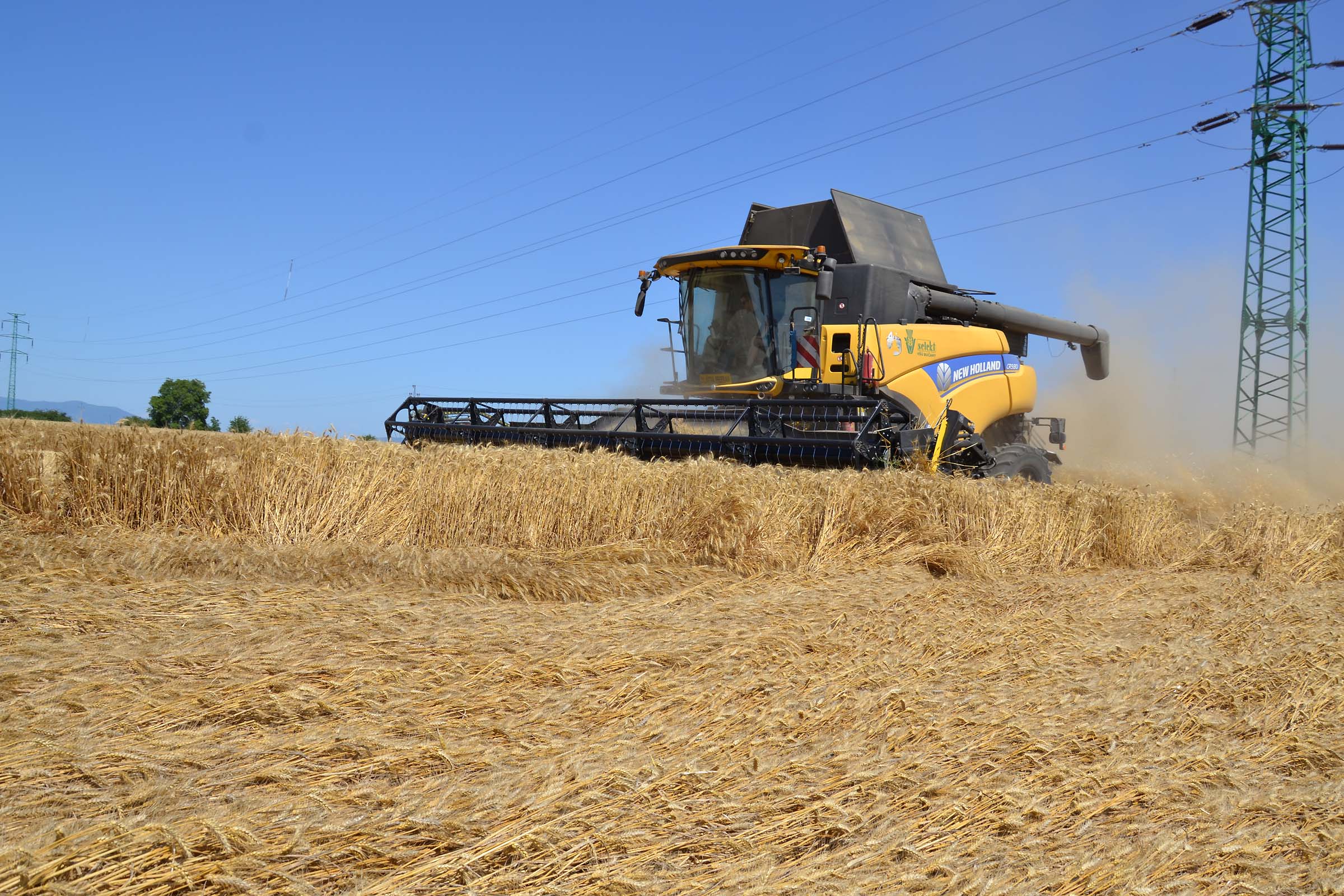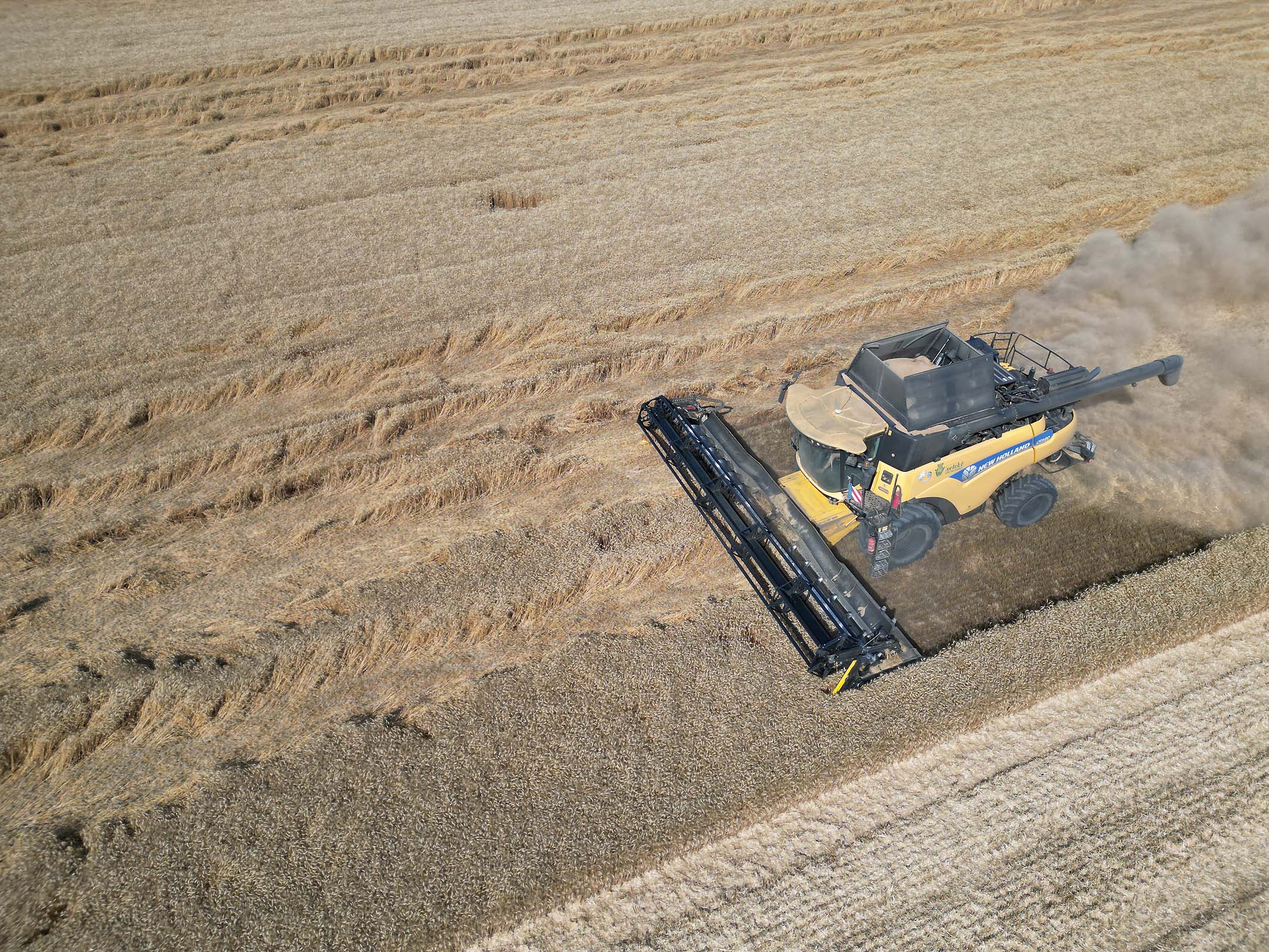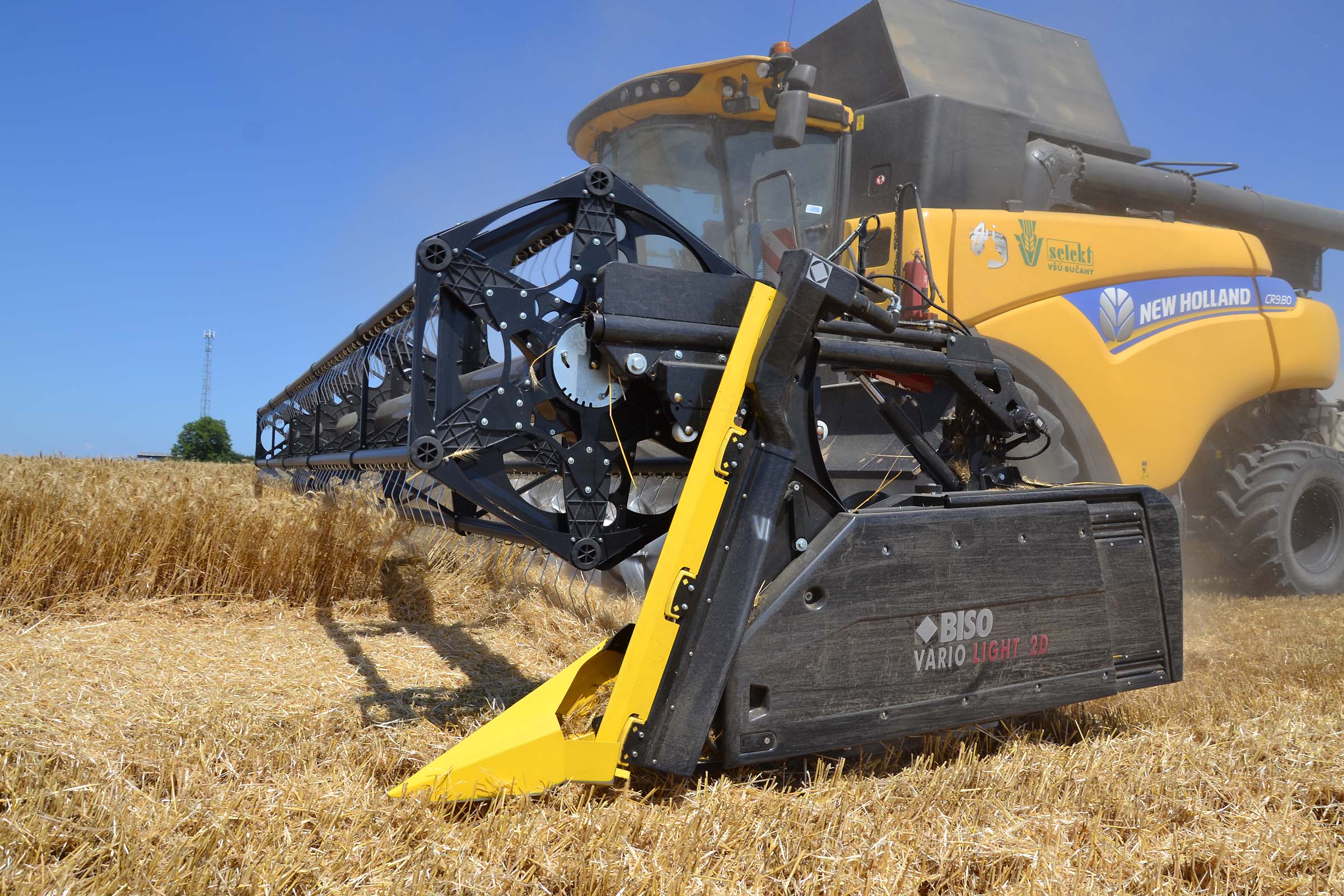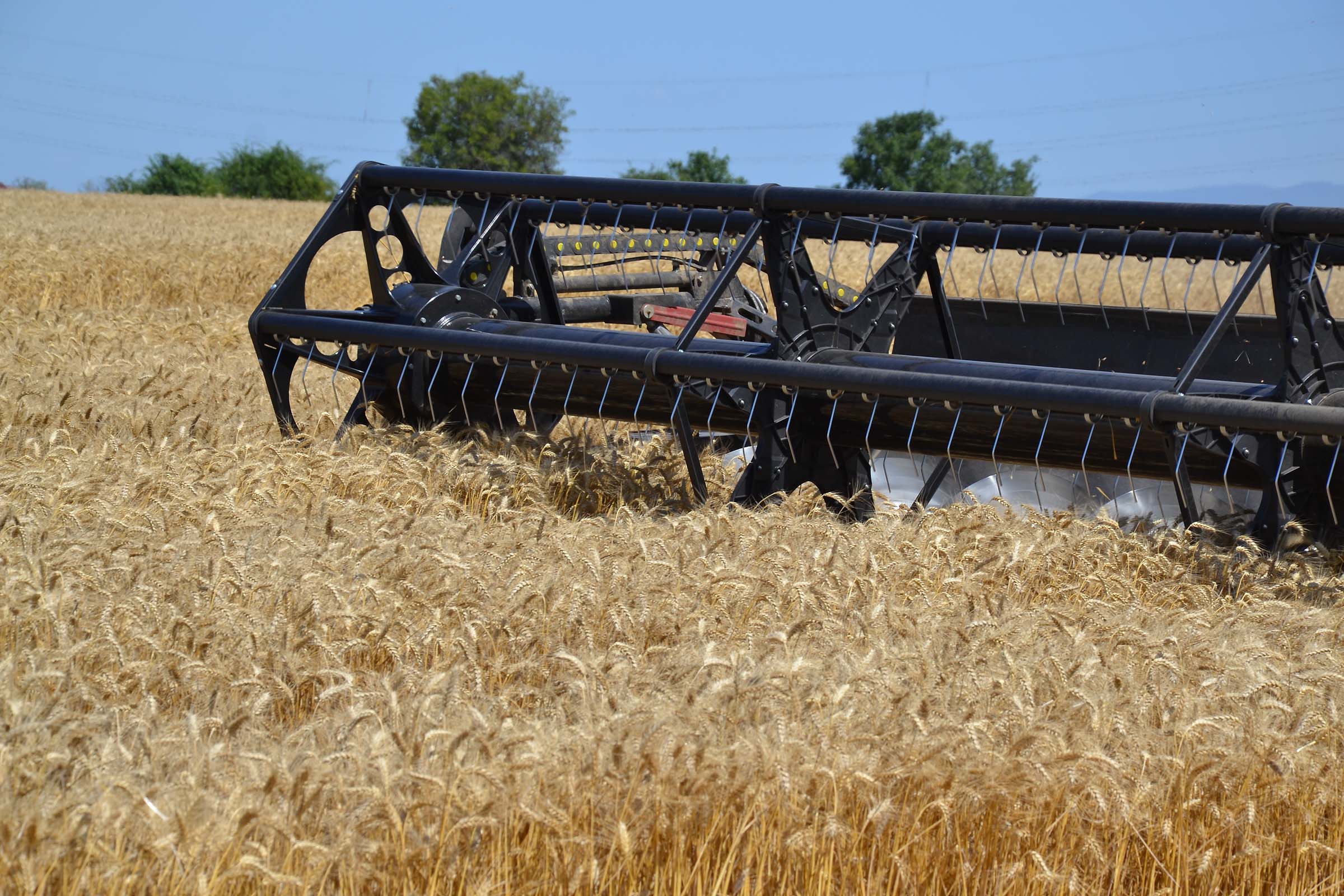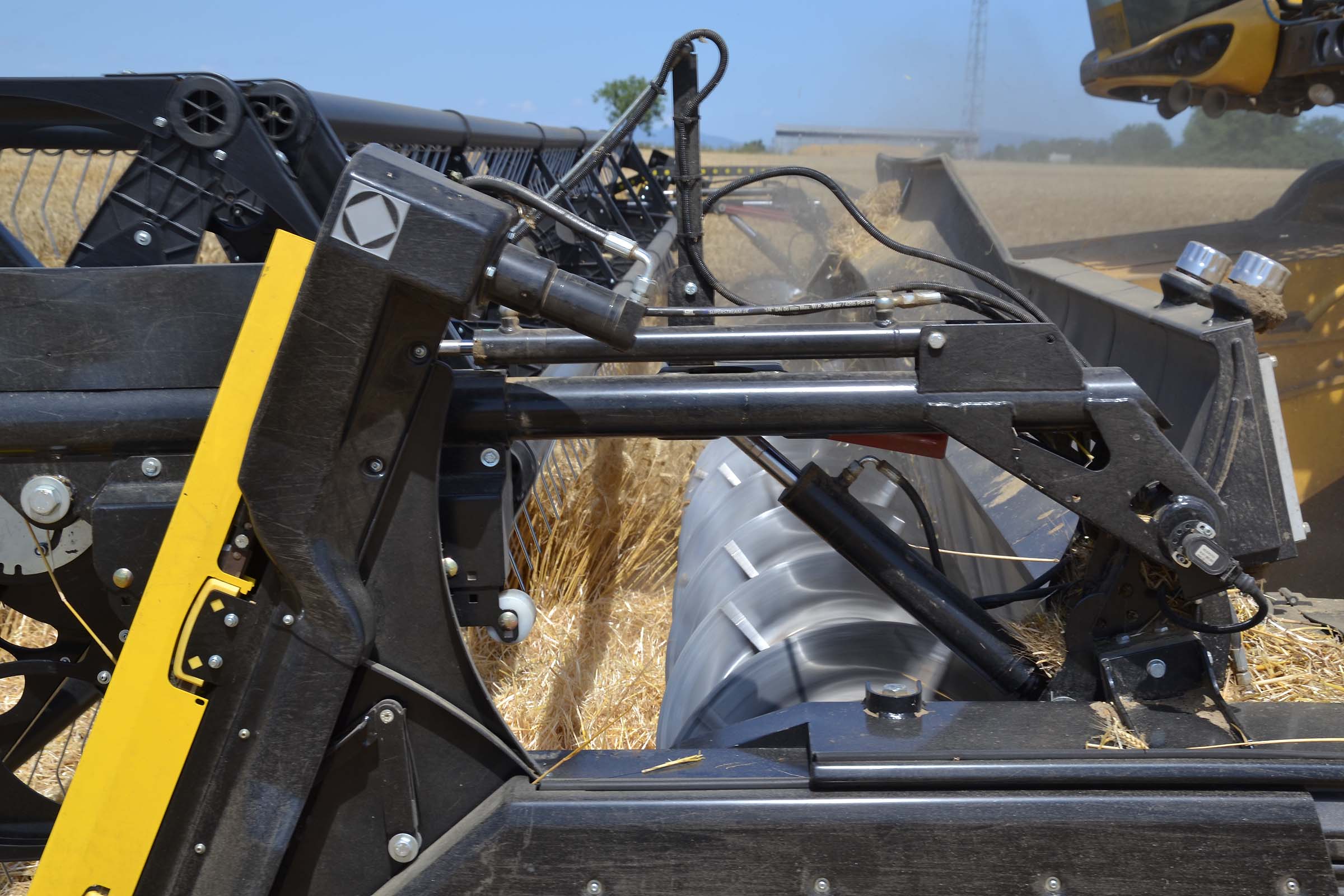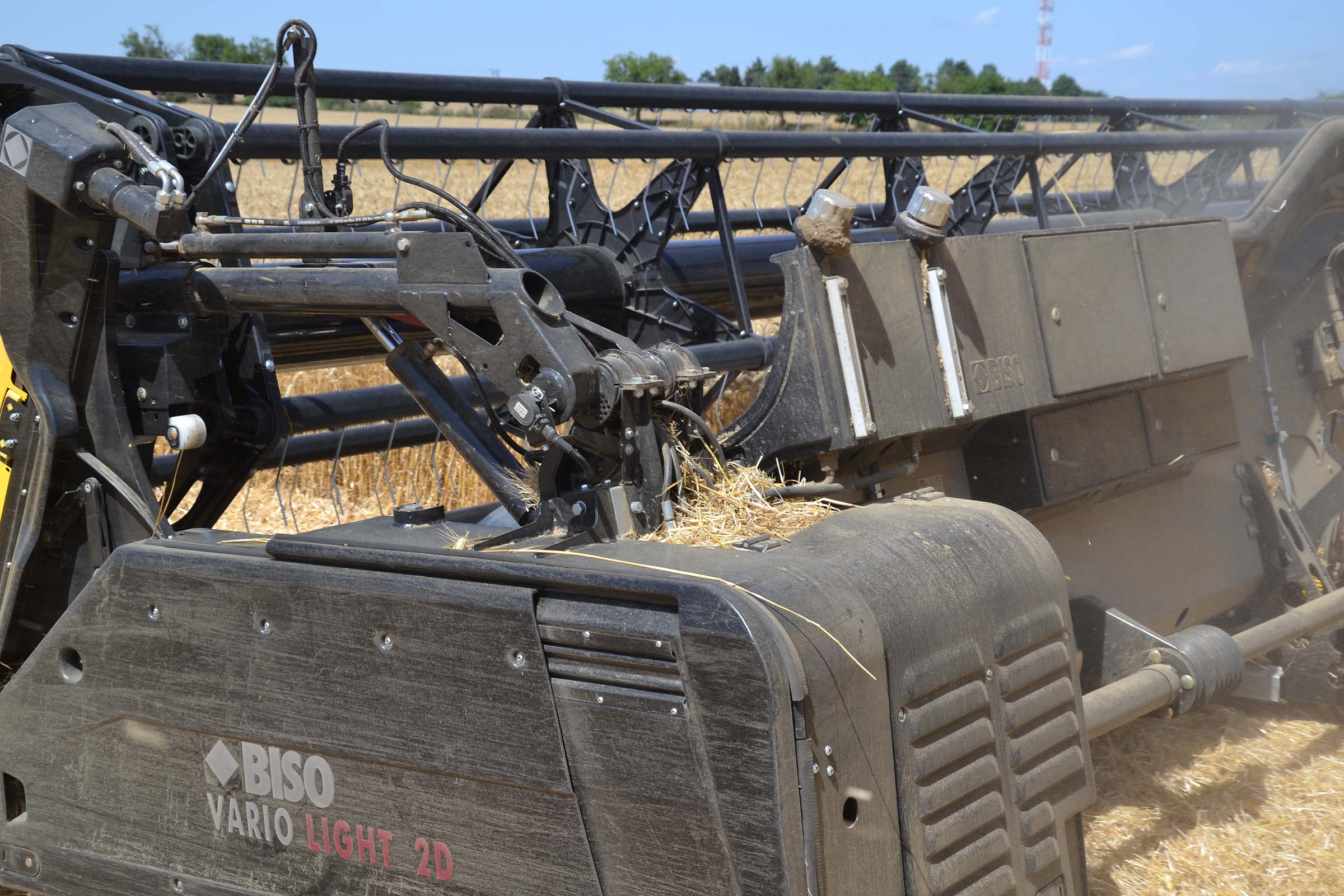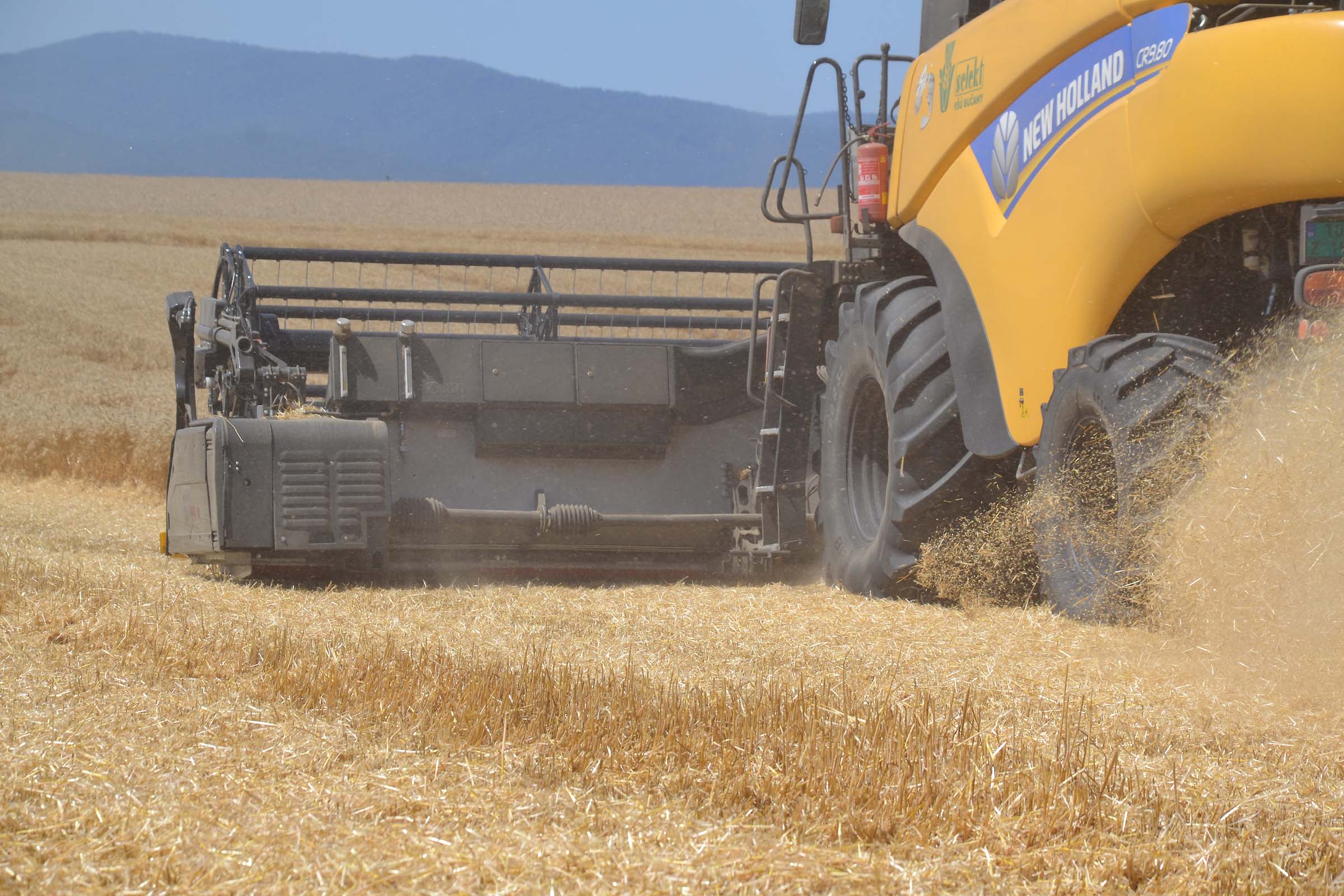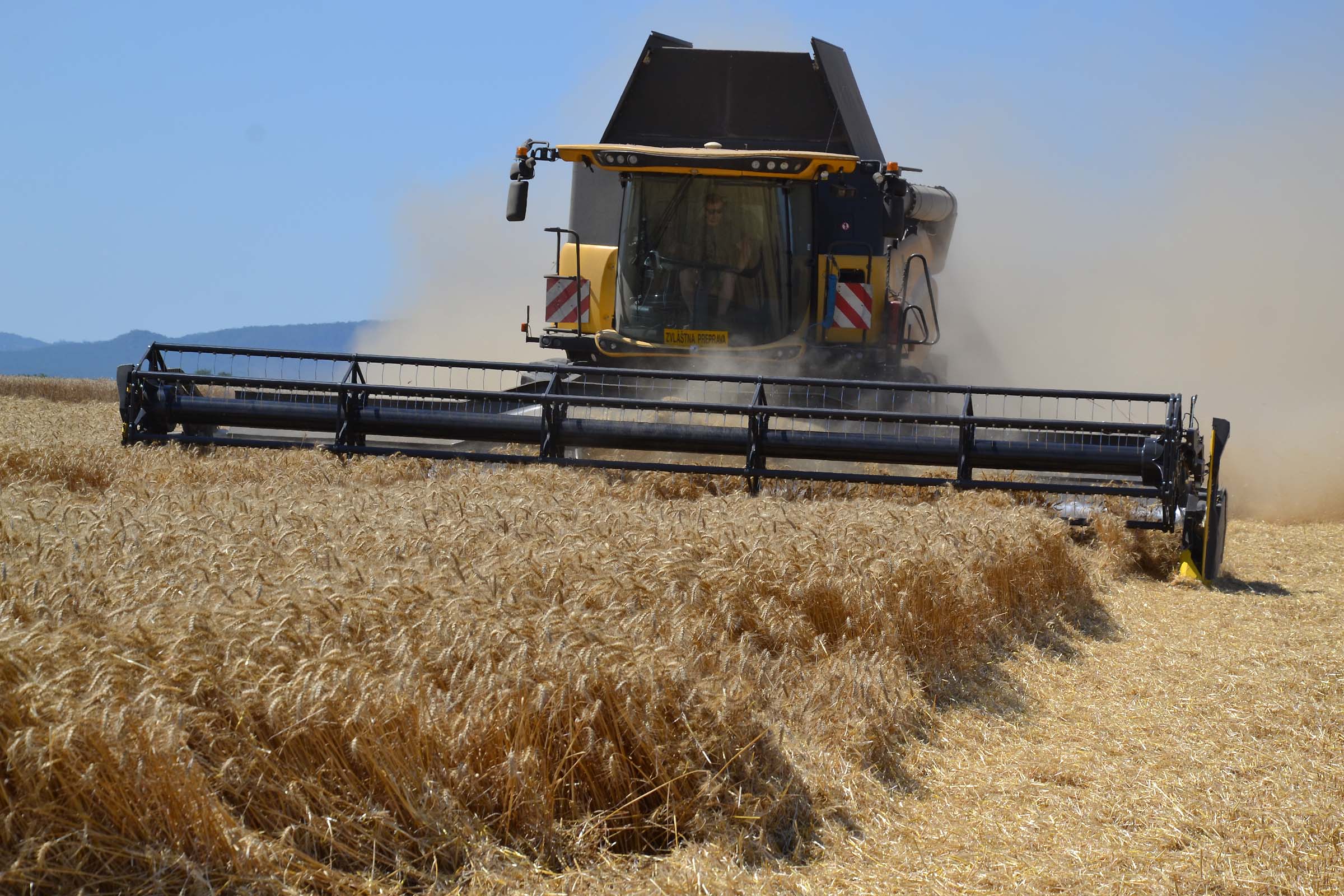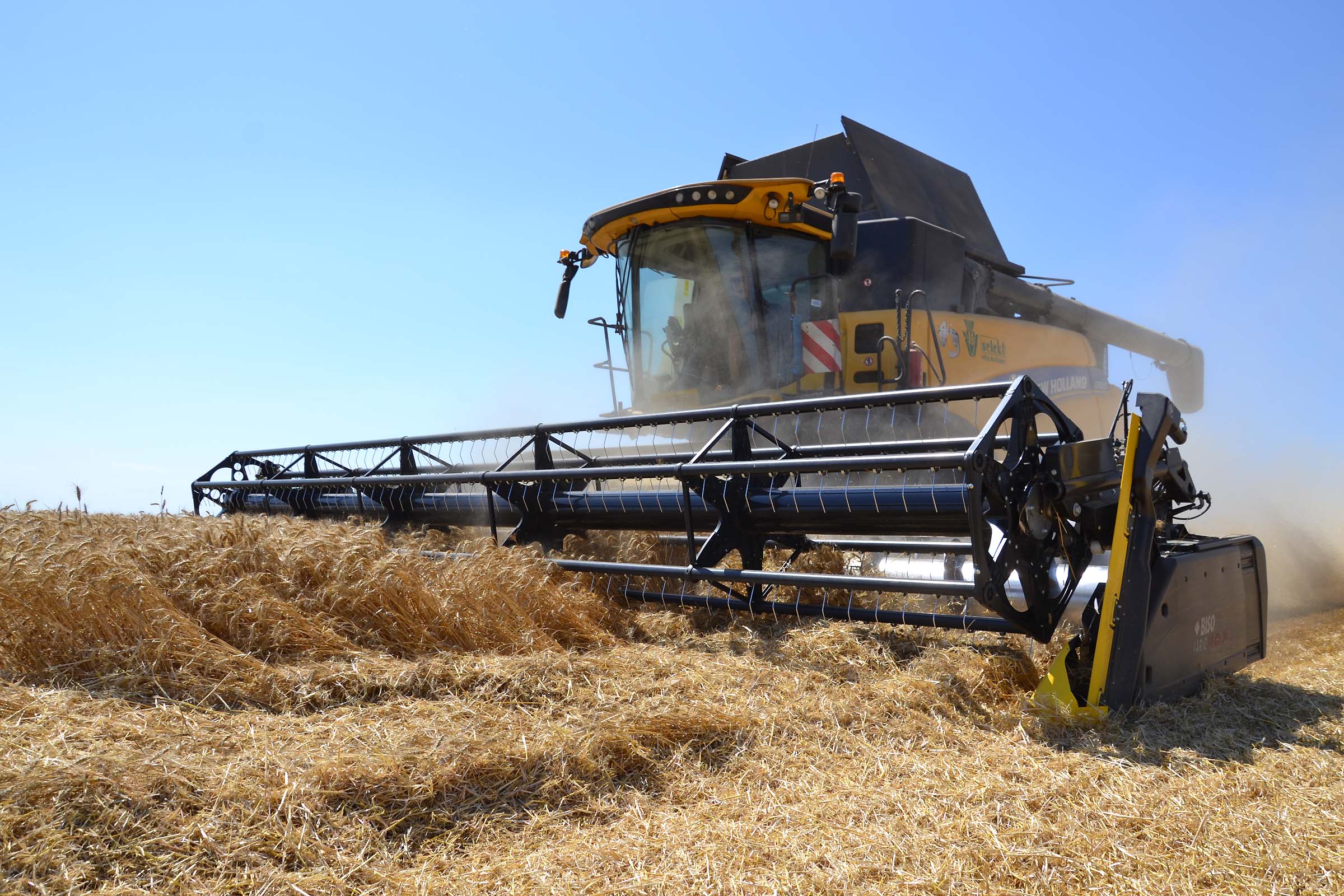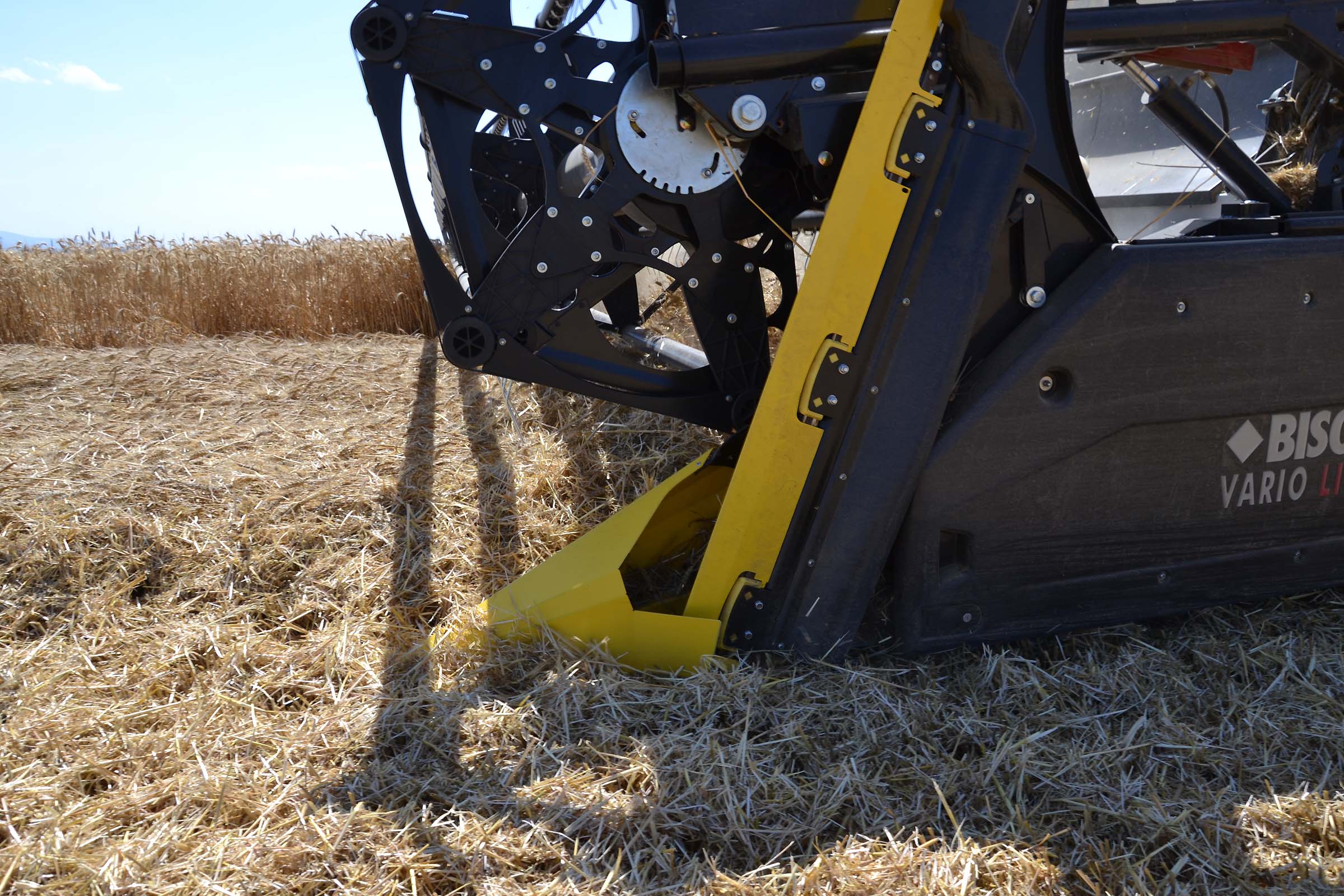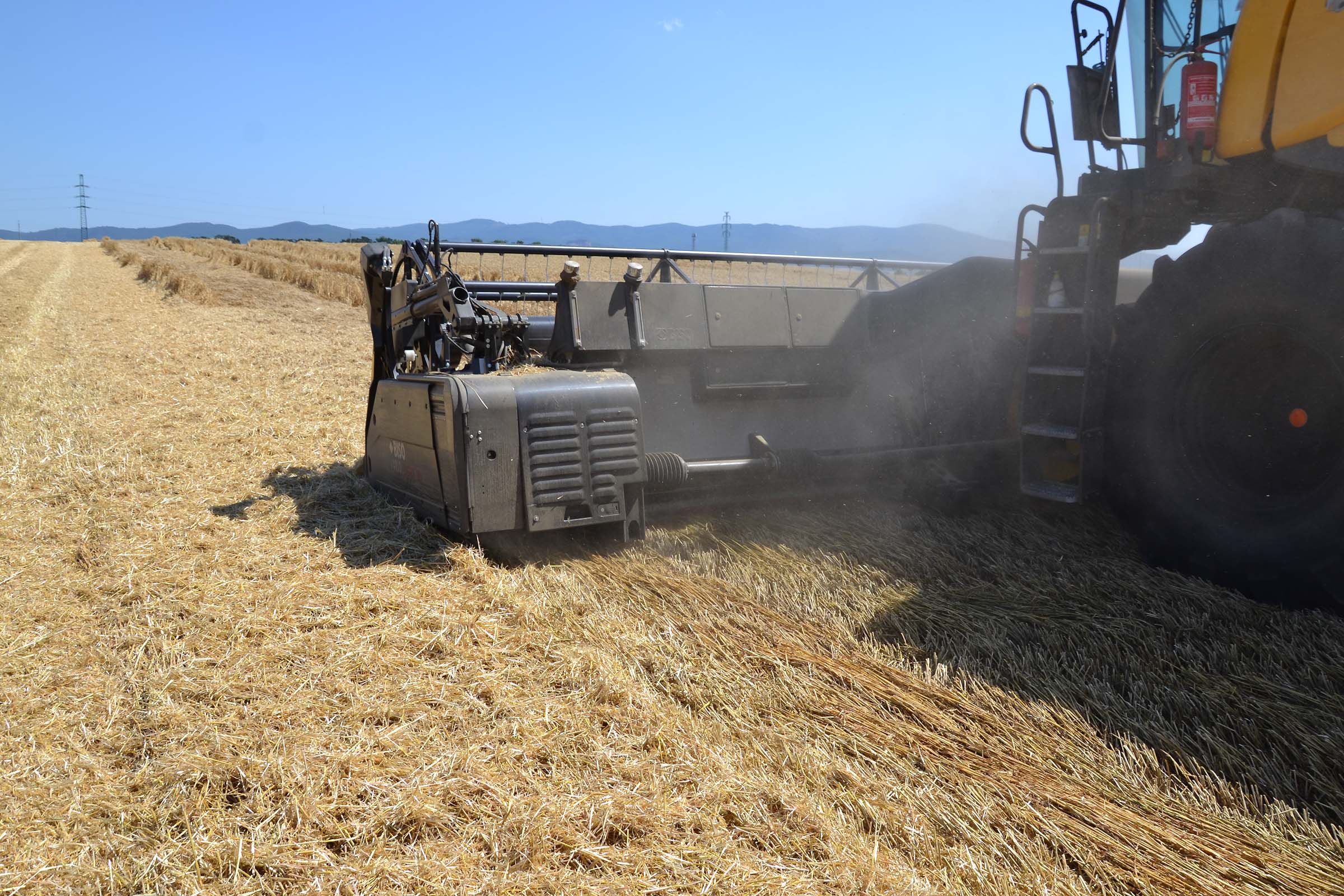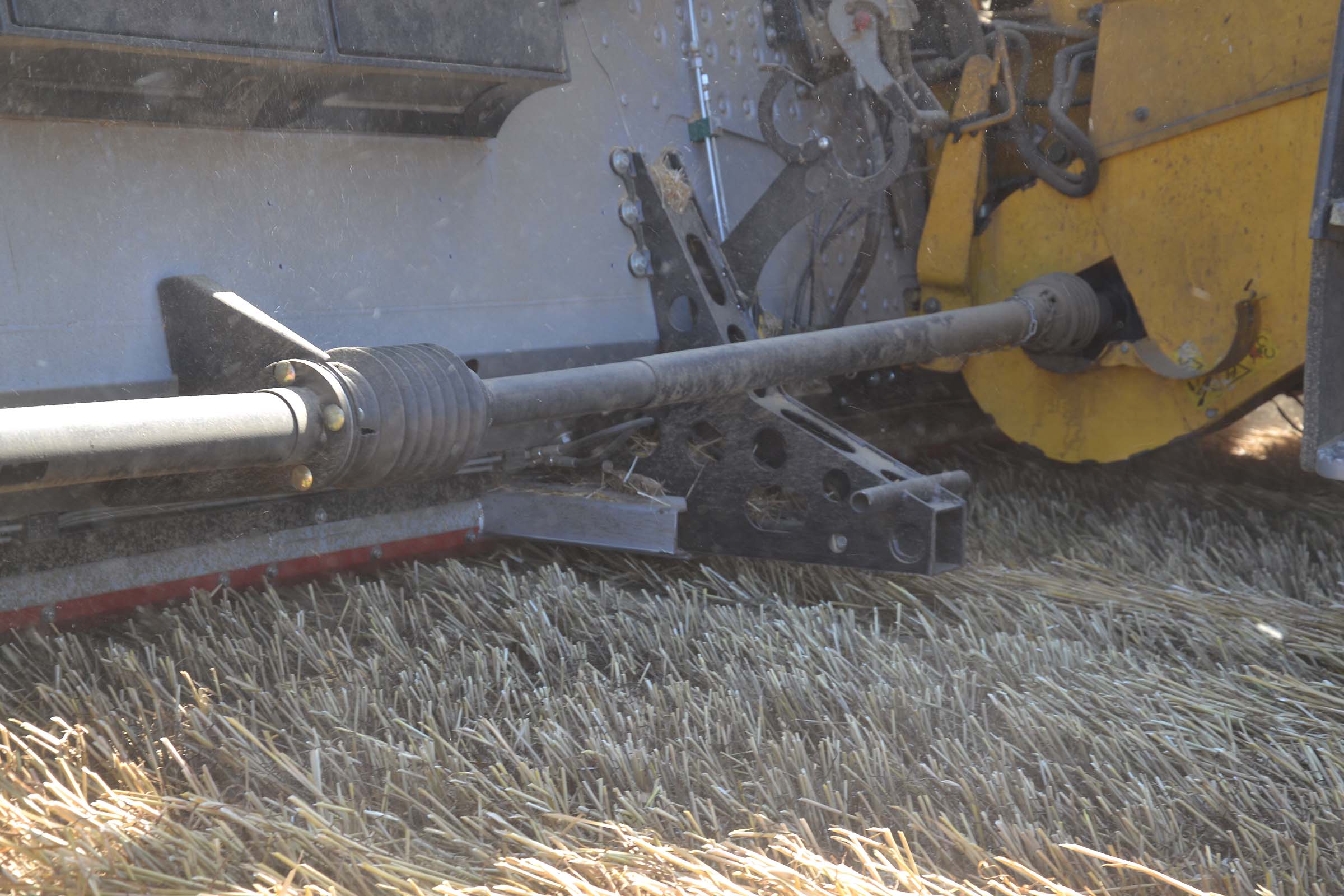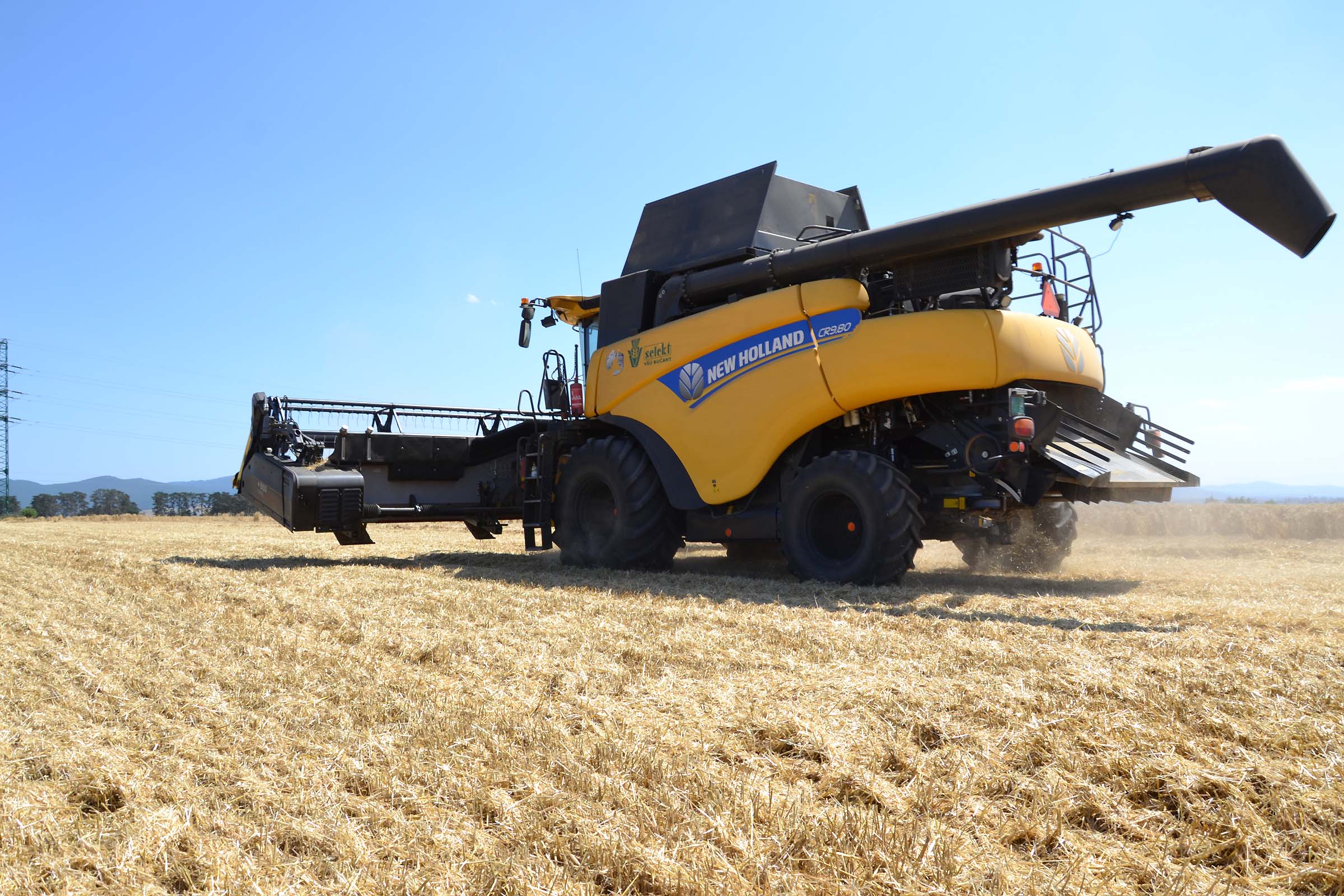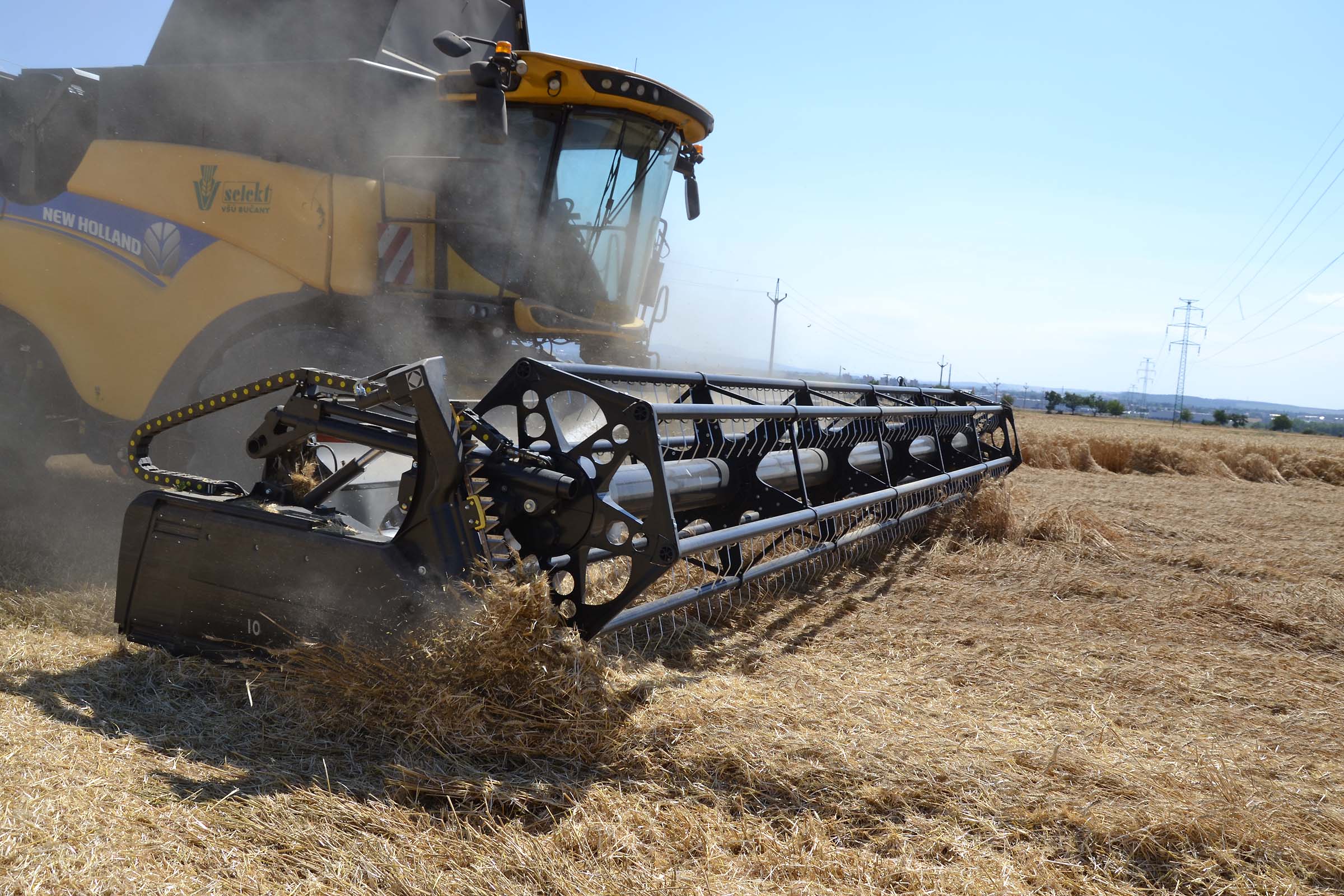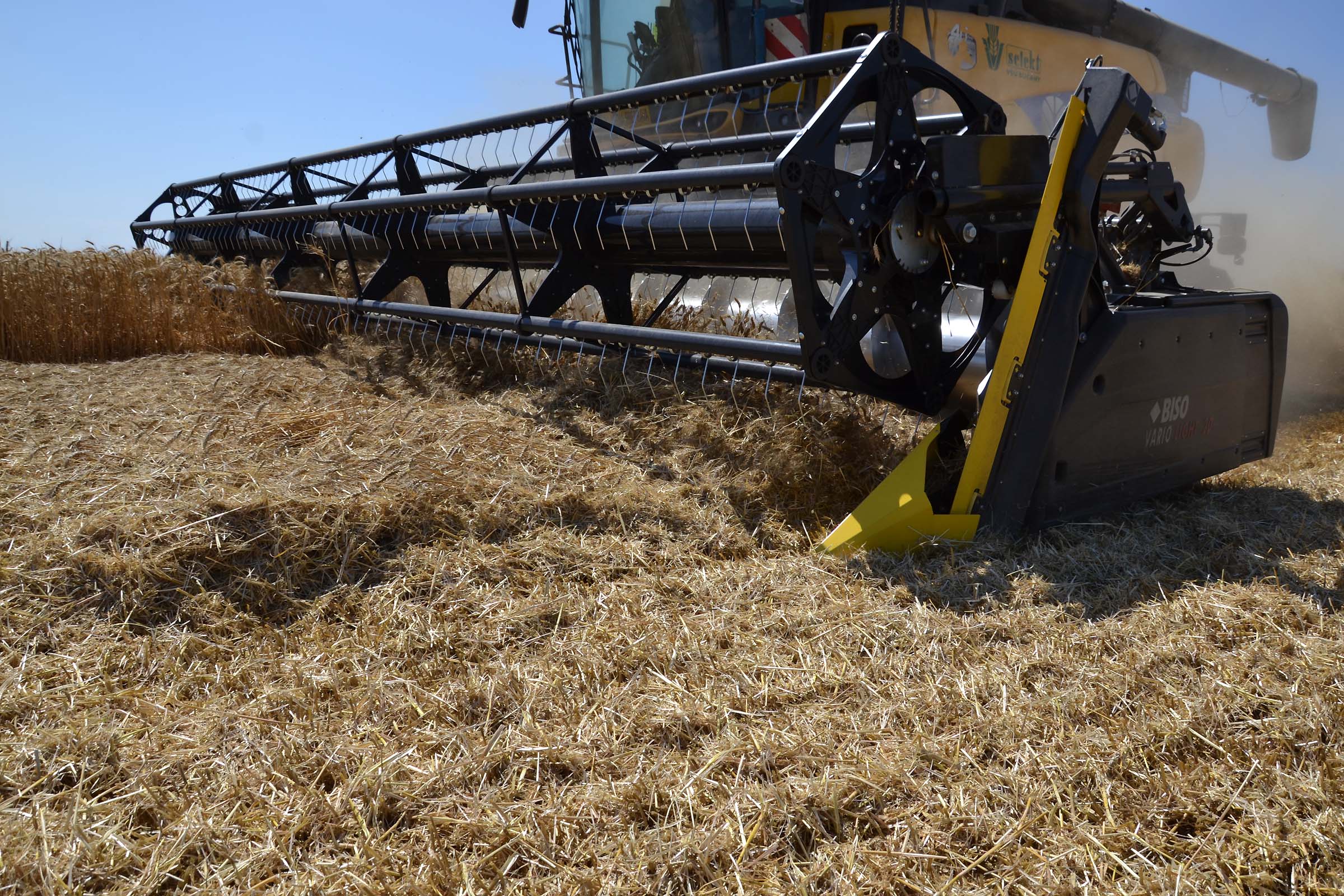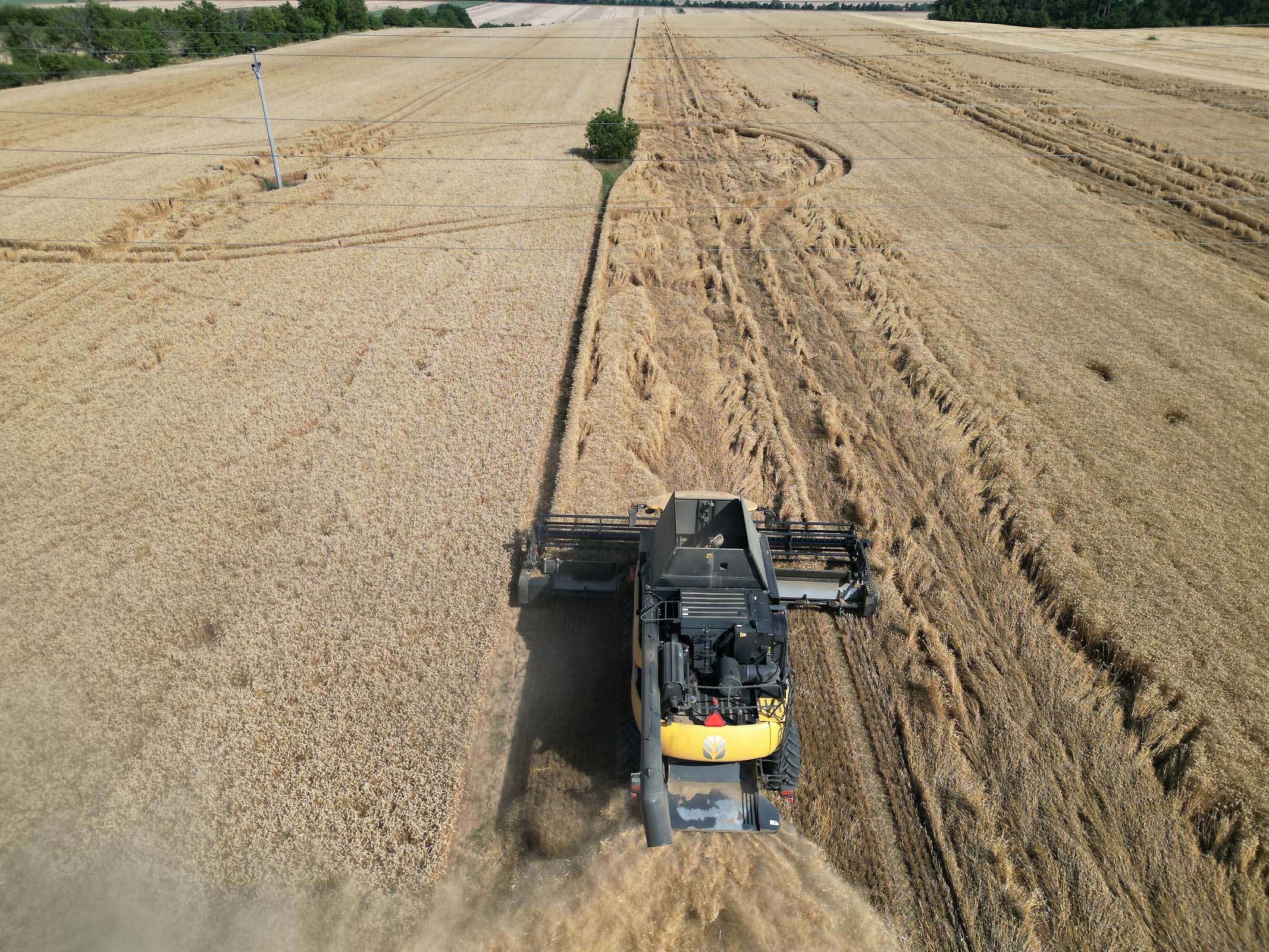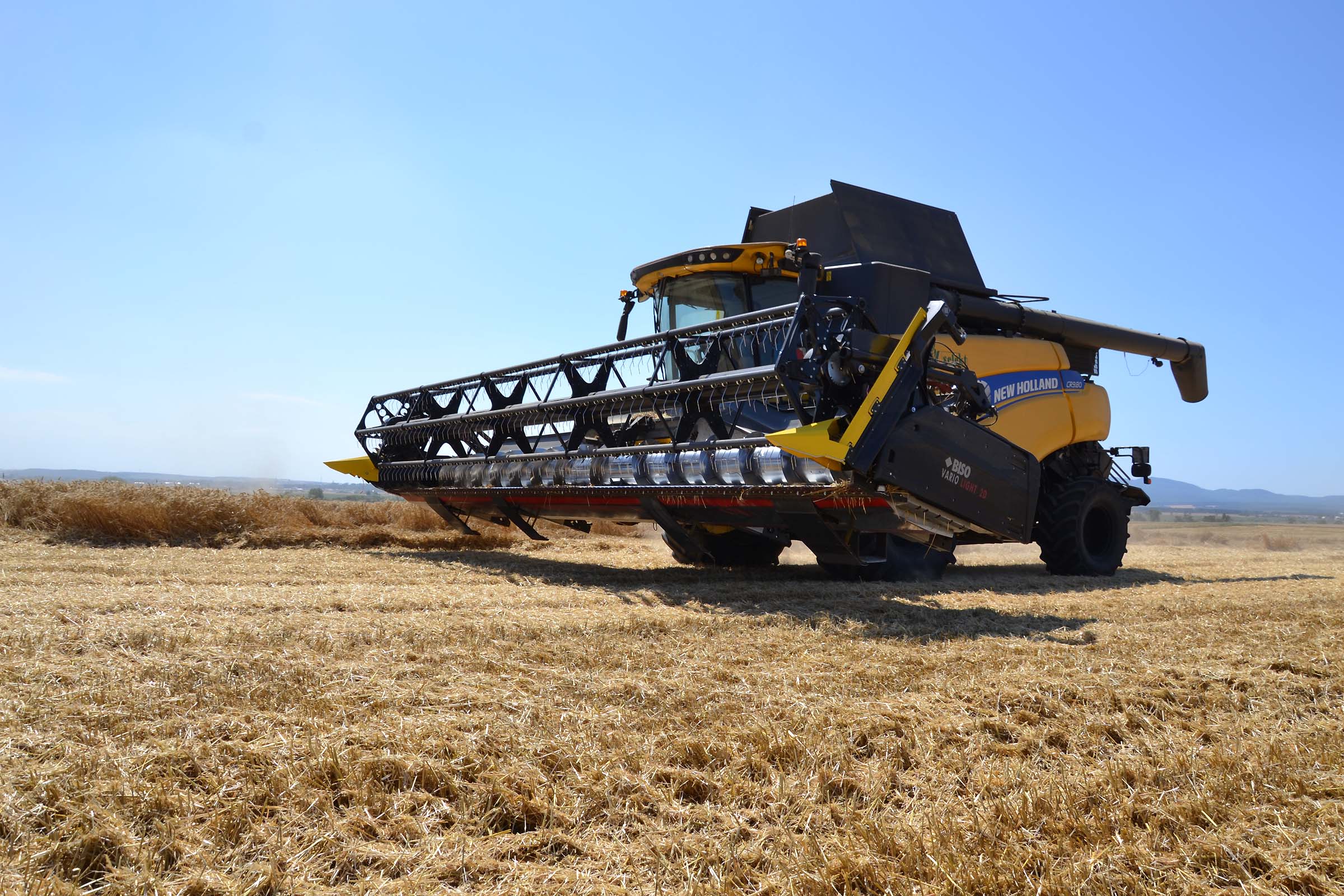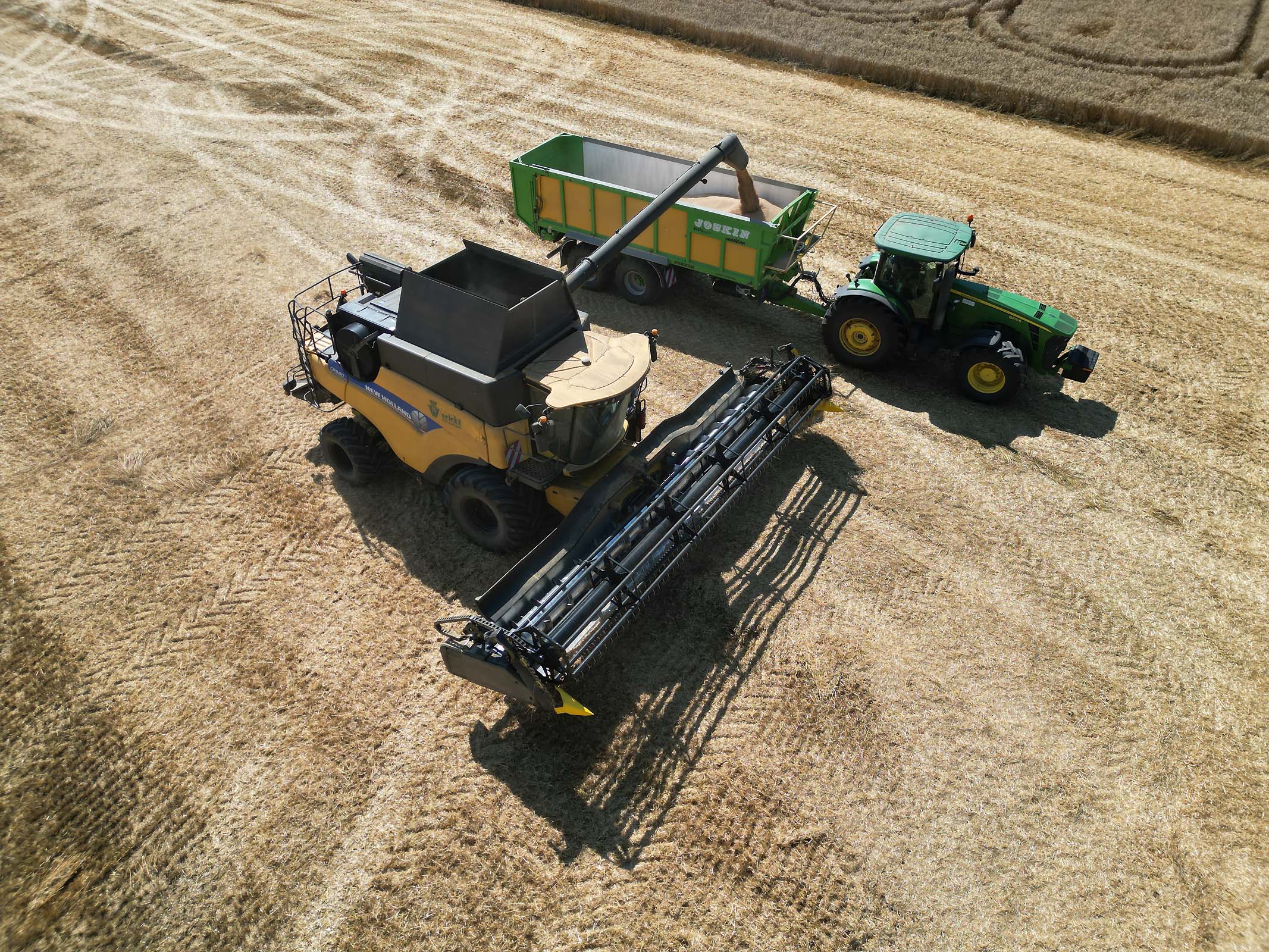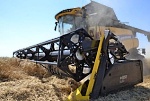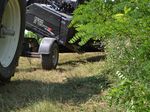BISO 2D – IN THE FIELD
BISO 2D VARIO 770 - 1560 COMBINE HEADER RANGE
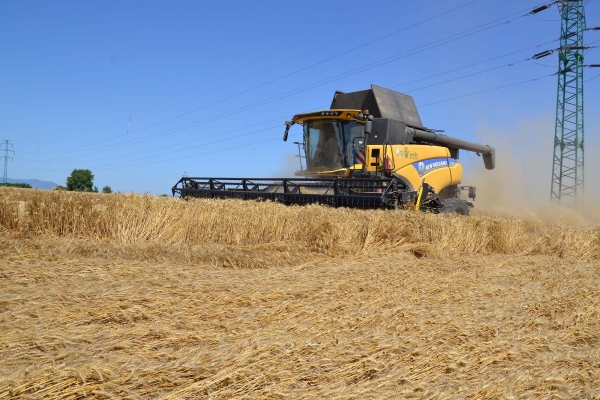
The BISO 2D VARIO series of combine headers is designed for high-performance combine harvesters that require perfect feeding of the harvested material under very different conditions. Drivers are exposed to considerable stress during harvest days in order to achieve high performance, minimal losses and also minimal wear or damage to the machine. The 2D model range gives drivers a choice and the ability to react quickly to the current harvest situation.
Header BISO 2D920 VARIO.
The "VARIO" headers have already fully established themselves on the market. They have become the standard. On a global scale, Europe is wetter than America, Australia or South Africa, and headers with auger still dominate. This is also the basis of the 2D header. This is nothing new, in our case it is a time-tested design solution. Its main advantage is literally unbelievable performance (throughput), versatility and, what is particularly important every day, long service life and low operating costs. From this point of view, there is a fundamental difference between the 2D770 and the 2D920 (and larger) models. Currently, one of the most popular working widths, i.e. the 2D920, already has knife drives from both sides and therefore also auger drives with central support. To give you a better idea, it is the same design as the larger 2D1070, 2D12030, etc.
The adjustment of the augers in the BISO headers has been very comfortable in the past. Most drivers set the height of the auger and usually do not change it much, but in the case of rotor harvesters and the need for high throughput (e.g. in rapeseed), it is advisable to lift the augers from time to time. It's a matter of a minute before you use a ratchet wrench to lift the augers (left and right) in the side mounting and on the center console.
Thanks to the fact that most of us grew up on fixed cutter bars with a auger, most of today's drivers understand the logic of augers and know how to adjust them. The comfort that is associated with the adjustment on the BISO 2D headers will be appreciated by every professional.
The 2D VARIO model range covers working widths from 7.7m to 15.6m. It's a package of proven technologies that we've been using for years. It is a premium header for high-performance combine harvesters.
Advantages of the VARIO header and then some.
The 2D VARIO header has a vario table that slides under the main frame of the cutterbar. Thanks to this patented solution, the bottom of the header is made of Hardox and the hydraulic cylinders of the vario extension are completely covered. This feature has been typical of BISO headers since 2001. Another typical feature of our headers is the so-called tip tilting. While riding, you can change the inclination of the header and therefore the position of the double-fingers and be more aggressive, literally touching the ground. Thanks to this solution, you can literally "shave" (as the owners of our headers often say) the flat crops without the use of crop lifters. Thanks to this feature, you can get very close to cutter bars with the FLEX module with the fixed VARIO table. You can achieve very similar results, if the land is flat and you have a suitable header width according to the width of the tillage machines.
From the picture you can clearly see a slight tilting of the header "on the tip" for better cutting of the flat crops.
You need to react quickly in the field
If the combine is running at a home company, working with it is somewhat easier for the crew. They know the conditions, they should know the condition of the vegetation and be able to orient themselves in general. It's a bit different for contractors, who are particularly exposed to the need to react quickly to harvest conditions that they see in real time. The 2D VARIO header has all the prerequisites for this. For example, the transition from barley to rapeseed is very fast. The side knifes are integrated into the side walls of the cutter bar and only need to be placed in an upright position when you arrive at the field. For the 2D series, we only install hydraulic side knifes drives. We can turn them on or off at any time while driving, even in the tilted position (suitable in flat crops, where long straws can get caught behind the divider). If they get stuck on a branch or "tap" on the ground, they simply stop and start running again when released.
Reel with hydraulic drive and hydraulic motor integrated into the support tube. It has electric tilting of flexible tines and integrated protection against winding long stalks.
Thresher drivers are becoming more and more demanding
There is currently a shortage of good combine crews and the machines they take care of are very expensive. Already typical for the CropRanger series was such a small thing as a water canister with a soap dispenser for washing hands. This is followed by a small tool box for changing the segment of the knife so that the driver does not have to open the side panel of the harvester and has everything in the area of the stairs to the cab. And these are just the little things, which now include the 2D line of oil lubrication of the drive chains of the augers.
What needs to be done to make the drivers like their headers? Above all, they must not have problems. Problems are stress, and stress is not good when you drive from morning to night. The cutter bar is the "first to hit" on the combine harvester and is in contact with the harvested material and the land, so most of the problems are usually caused by us. But it is necessary to take this into account, to have a spare knife in the header trailer, double-fingers in the box on the header, of course knife segments, the knife head, but also the knife drive belt and the like.
The auger is key to the versatility of the header, high performance, low operating costs and long service life. The 2D920 is already available with a central support and drives on both sides.
The great advantage of the BISO 2D VARIO headers is that they are based on a proven and well-established design school in our markets. The drivers understand their principle. They know how to set them up, they know how they work and they are readable for them. With a certain degree of simplification, we can say that we use hydraulics and electrics from the CropRanger series on the 2D series, which is extremely important for operational reliability. It brings a system that has been proven for many years, which is legible and very easy to repair in field conditions. The drive of the reel is hydraulic and the oil is supplied from the combine. The hydraulic cylinders for lifting and extending the reel are very accessible from the point of view of the service. The pumps and the hydraulic control block with solenoids are located on the left rear side of the header frame, i.e. in the traditional place. The connection to the combine is also classic, including a control box in the cab.
All models except the smallest 2D770 have drives from both sides and a split auger. This means that in difficult conditions (wet barley) and with an already blunt knife and double fingers, the gearbox of the 2D1070 cutter bar only drives the 5.35m long knife. For the 2D920 model, it is only 4.6m, so the load on the knife drive (belt, gearbox, knife head and the knife itself in the space at the knife head) is quite minimal even in very difficult conditions.
The 2D model series is maximally oriented towards the combine driver. The picture shows hydraulic oil and hand wash tanks integrated into the grain splash guard.
The adjustment of the augers is superfluous and, most importantly, fast (vertical). The reel has an electrically controlled adjustable inclination of flexible tines, which is especially necessary when lifting lodged crops. The speed of the reel, lifting and extending is controlled by the hydraulic circuits of the combine harvester. The copy system uses two or 4 skids and is equipped with potentiometers from the manufacturer of the combine. Calibration then takes place as standard for the given brand of combine.
The drivers can smoothly change the extension of the VARIO table, i.e. the distance of the knife from the auger, while driving. The same applies to the angle of the header for the best possible "cutting" of the vegetation on the given plot. The side knifes are fully integrated and do not need to be fitted, which is important if the machine is operated by only one driver. The header can also be stored on the BISO trolley with the VARIO table extended, and for morning maintenance it is possible to have the reel (mechanically secured) raised.
A characteristic design feature of the 2D series is the hybrid frame. That is, a combination of the main aluminum profile and steel elements. Due to its strength, the bar practically does not bend.
Short barley
For short barley, the VARIO is usually retracted so that the blade is as close as possible to the auger. In the case of barley, it depends very much on the moisture content of the crop (how lively the stalks are) and the condition of wear of the knife and double fingers. If everything is set up well, then very often the barley literally "flows" into the threshing machine. However, there are also situations when some operators push the VARIO forward, set the angle of the bar to a higher aggressiveness, and the reel that extends above the knife must also do its job in such a situation. This strategy is often suitable for low and sparse, often green stands (during first pass around the field or near forests, etc.). The variety, humidity, weed infestation or any green tramlines from the sprayer have a great influence on the setting.
High-performance threshers need equally powerful headers with maximum possible operator comfort.
Rye, triticale and high-yield wheat
Crops where good crews use multiple setting strategies. Especially if you have nice standing crops with a high yield, you can test your combine to the maximum. Especially with the advent of rotor combines, there was an opinion that it was better to send the stalks to the feeder house first. To do this, simply pull out the VARIO table while driving so that the stalks fall on the bottom of the table just in front of the auger. If you have an overripe crop or a complicated variety, this strategy will almost completely prevent losses in front of the combine (header), because you will "store" your crop in the stainless steel table and even the grains that fall out will all get into the feeder house with the mass. The reel plays a minor role here and only slightly holds the standing stalks at the moment of cut. However, this method (ears first) is also used by many drivers of BISO headers with combines, which have a traditional tangential threshing mechanism, usually with a separator or with an upstream acceleration drum.
Thanks to the patented solution of the VARIO table, we are able to slide the VARIO under the main frame of the header and thus obtain a range of extension of 70 cm with the possibility of pulling the knife bar to only 35 cm from the auger in crops with extremely short stalks (barley).
However, there is still a large group of "traditional crews" who, when they enter a clean, perfectly dried and upstanding crop, almost pull the VARIO table, i.e. pull the cutter bar relatively close to the auger, immerse the reel in the stand (each a little differently) and let the cut standing stalks with wiggle ears gracefully collect and wiggle in front of the thumb before disappearing in the inclined feeder house under the combine cabin.
From our point of view, it is not important which setting is better. But the fact that the driver has the ability to react quickly and choose the best possible settings in a given situation according to specific conditions. It can be different in the morning, different at noon, and of course the situation can be completely different in the evening or at night. It is also important that the mentioned settings are made while driving from the combine's cab and therefore it is possible to immediately evaluate the result in the mass flow.
The integrated side knifes can be switched on in both the upright and tilted position and can also be used in combination with a mounted divider, which is mainly used in flat crops.
Peas and soybeans
There is a well-known rule: The lower we go with the knife to the ground, the greater the wear. Especially in sandy soils after rain. As standard, the bar is fitted with forged double-hardened BISO double fingers of top quality. With a BISO knife, of course. As an alternative, for a small surcharge, we offer the so-called SCHUMACHER KIT, i.e. welded Schumacher steel double fingers (dark red design). Of course, the Schumacher knife is also included in the set, and a special BISO transition head for Schumacher knifes is required for this.
This solution has historically been preferred mainly by owners of JD, Laverda and Deutz-Fahr combine harvesters, who are used to this brand. We have been offering this SCHUMACHER KIT for several years, so we can confirm that we prefer it for FLEXI modules and it is also ordered by customers for 2D cutterbars working in stony conditions. However, like any solution, it also has its pitfalls. Welded steel tines are very durable, but if they are stuck in the wood in the soil, for example, and bend, they cause considerable damage to the cutter bar and usually to the entire header. The advantage here is that the forged classic double finger will crack in the event of an impact and will not cause consequential damage.
In flattened crops, it is very important to extend the VARIO table, the angle of the cutter bar and the work of the reel. That is, the possibility of reaching the feeder in front of the knife bar and possibly even below its level.
Rape
The vario table slides out almost to the maximum. The dividers are removed, the side knifes are set up and, depending on the nature of the rapeseed crop (whether or not it has been dessicated), we can lift the augers. In the case of rapeseed, it is a good idea to pull the cutter bar a little "on yourself", i.e. choose a negative tilt so that the fallen grains slide down the VARIO table backwards to the auger.
The side knifes are attached to the bar so that they are "very aggressive", as they say in the field. This means that they do not have any skid at the bottom and the lower elements of knifes (segments) can easily touch the ground (depending on the header angle). The side knifes will therefore cut through weedy vegetation all the way to the ground. Due to the use of only a hydraulic drive, in the event of contact with a stone or branch, it pauses for a moment and then starts again. The last segment (at the bottom) can be cut off to reduce the risk of contact with the ground. Features especially important when running around the field.
In this picture you can clearly see the system of sliding the VARIO table under the main frame of the header and the black console of the VARIO table in a significantly redesigned design with adjustable rollers.
Flat crops
Similar situation to peas and soybeans. As a rule, it is a good idea to slide the VARIO table forward so that the cutter bar is clearly visible, tilt the bar slightly so that the double fingers can safely get under the flattened layer of mass. In this situation, the reel should be extended in front of the knife and it is necessary for it to do a good job, i.e. to lift the flattened "carpet" and get the mass above the knife. This is done by electrically adjustable steel flexible tines of the reel. The 2D VARIO headers use a proven roller track system, which prevents the tines of the spring steel reel from coming into contact with the segments of the knife. Of course, there is a significant risk of pulling the stone into the bar when harvesting flat crops. The extended VARIO table gives the driver a much better overview of what is going into the machine, but in reality, it is not possible to see the width from 7.5m and more only with eyes, so the typical sound is key - the clink when the stone hits the stainless steel bottom. It has been proven that "it can be done" and stop the insertion. However, the first protection against the intrusion of smaller stones is the stainless steel hump behind the cutter bar, which is a compromise between the ability to catch stones and at the same time not significantly restrict the flow of matter.
Of course, the important feature of BISO headers is retained: You can have crop dividers on (we have several types) and at the same time you can stand up the side knifes and turn it on. Likewise, you can have the dividers on, the side knifes folded down, and you can still turn it on at any time for a while if long stalks or tangled clumps of weeds accumulate in the space behind the divider, blocking the smooth flow of mass into the header.
For quality work and low wear and tear on the lower part of the cutter bar, it is necessary to have a well-functioning copy system. It is clear from the picture that we already have 4 copy skids on the 2D920 model.
In such flattened vegetation, it is sometimes good to turn on the side knife and free up the space behind the divider, which gets clogged with long stalks, for example, when mowing around the columns.
Different conditions require different strategies and quick reactions of the operator.
Especially with high yields, such crops are common and BISO 2D VARIO is designed for them.
BISO trolleys
In the vast majority of cases, the BISO 2D VARIO premium class cutter bars are delivered to customers in a bundle with the BISO trolley. In the past, we also had cutter bars with a width of 12 m mounted on BISO ProfiTrailer vehicles, i.e. only with the front steering axle. In recent years, trailers with steerable front and rear axles have become more and more popular. Headers with a working width of 10.7 m (2D1070) are usually already paired with trailers with a steerable rear axle (BISO ProfiSteer) and this trend is already carried over to headers with a width of 9.2 m.
It is important for the crew that the trailer is following the combine harvester well when moving, and the critical moment is the raid on the land. We mount 4 or 6 supports on the trolleys so that the header is well stored and suffers as little as possible when moving.
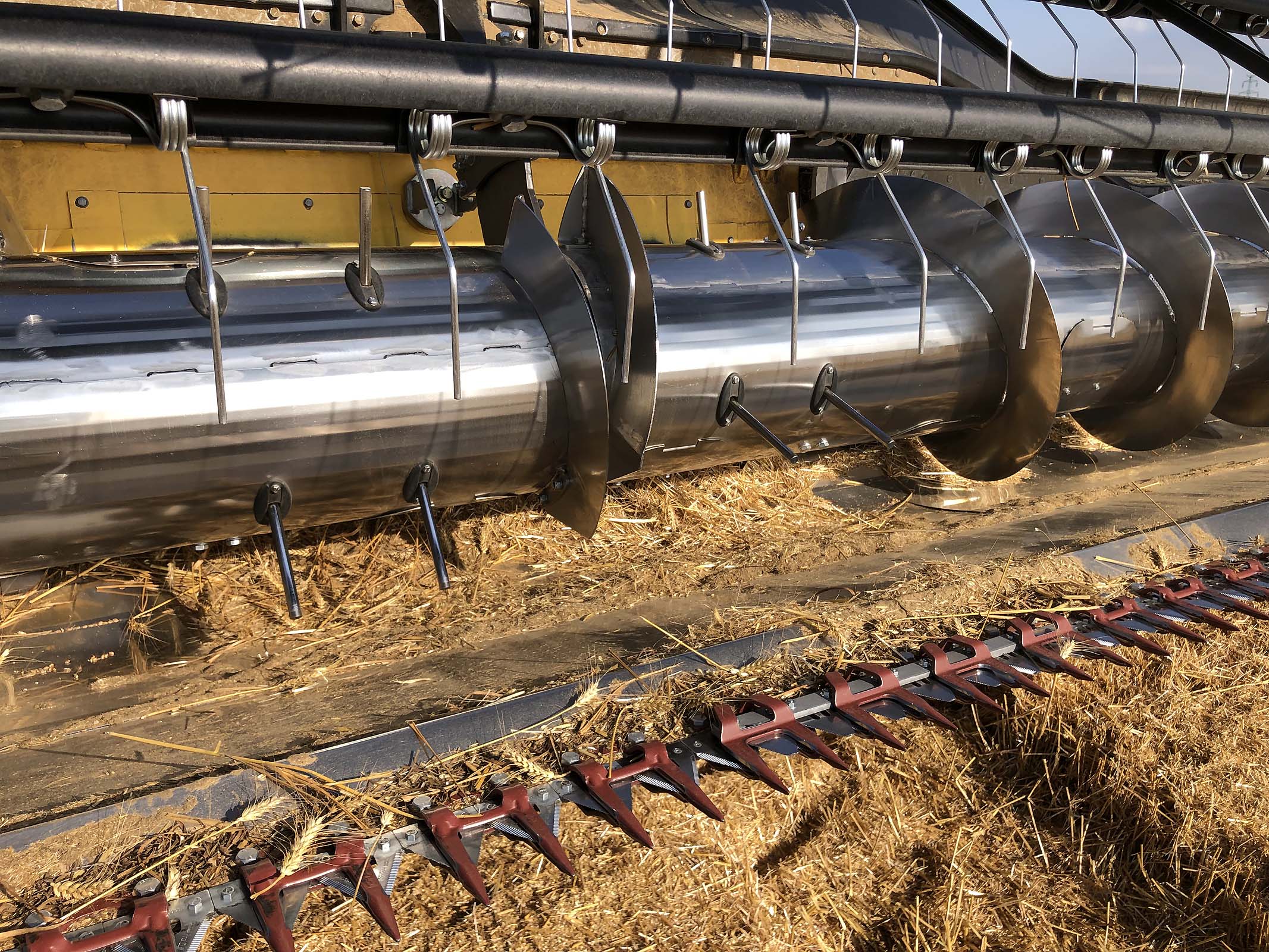
This header is fitted with stainless steel augers. The standard equipment includes a stainless steel VARIO table and a SCHUMACHER kit, i.e. a set of double fingers and a Schumacher knife.
The lower part of the header is completely covered by hardox sheets.
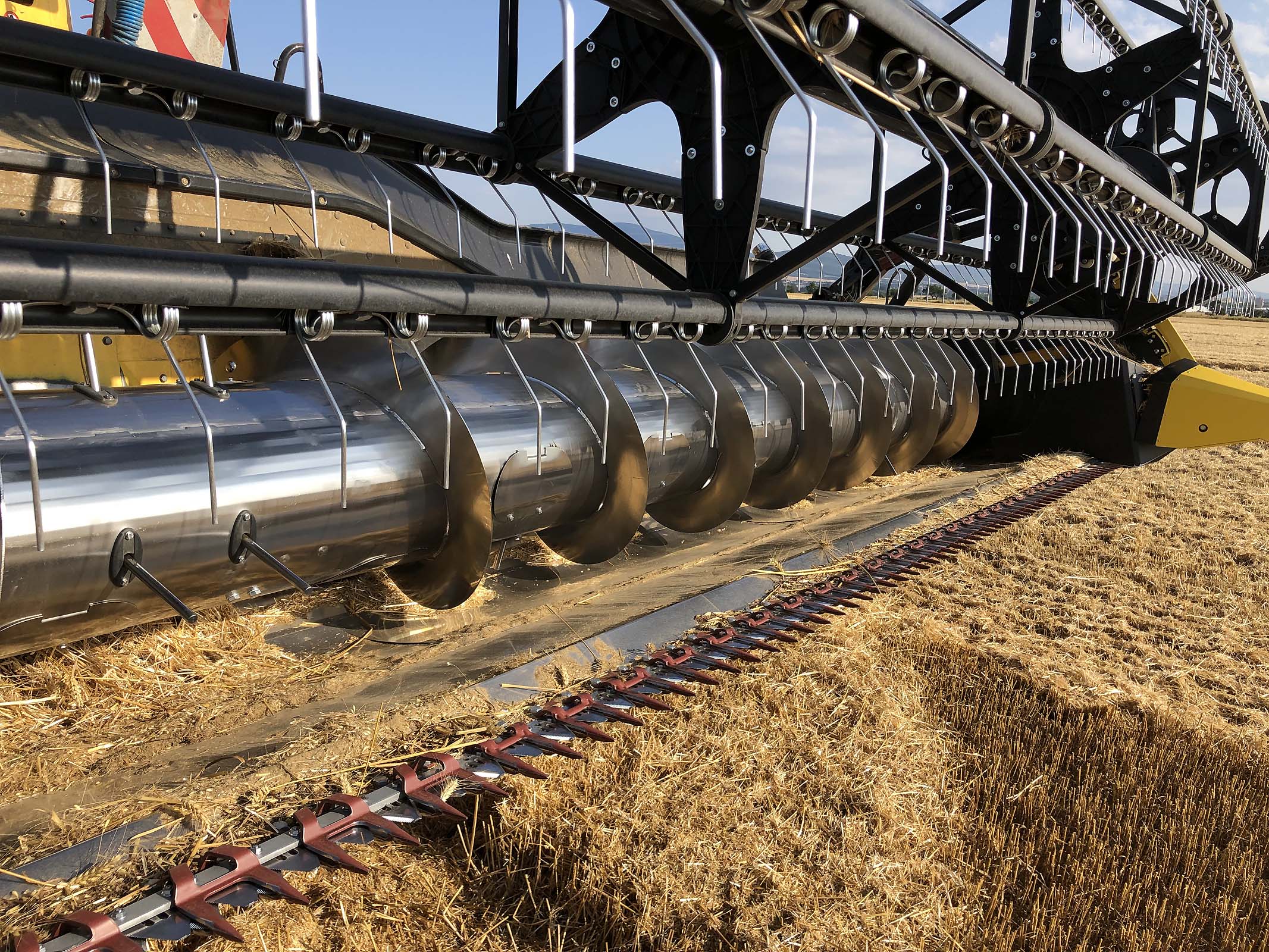
The design of the header is oriented towards high durability and minimal losses of harvested crops while being able to sufficiently feed high-performance combine harvesters.
What to say in conclusion?
The 2D model series uses technologies that we have been using in the company for more than 10 years. The difference is that they have been put together into the right "package" based on experience from customers and from different markets. It is a header developed for all types of crops, for high and low crops, for harvesting at high speeds, but above all for customers who emphasize minimal grain loss on the cutter bar, high performance of the combine harvester and top operator comfort. That is, the rate of change of the harvested crop with the ability to harvest multiple strategies of a given crop.
The market in Europe is dominated by headers with a auger in the VARIO design. Thanks to the hybrid frame and its strength, the BISO 2D VARIO model series allows to provide the benefits of this technology for working width from 7.7m to 15.6m.
More about the 2D VARIO cutter bars:
https://navigator.biso.eu/en/en-biso/harvesting-technics/biso-3d-varioflex-air-i/
Brochure in CZ version for download:
https://navigator.biso.eu/wp-content/uploads/2020/04/BISO-3D-VARIOFLEX-AIR-i-ENG.pdf
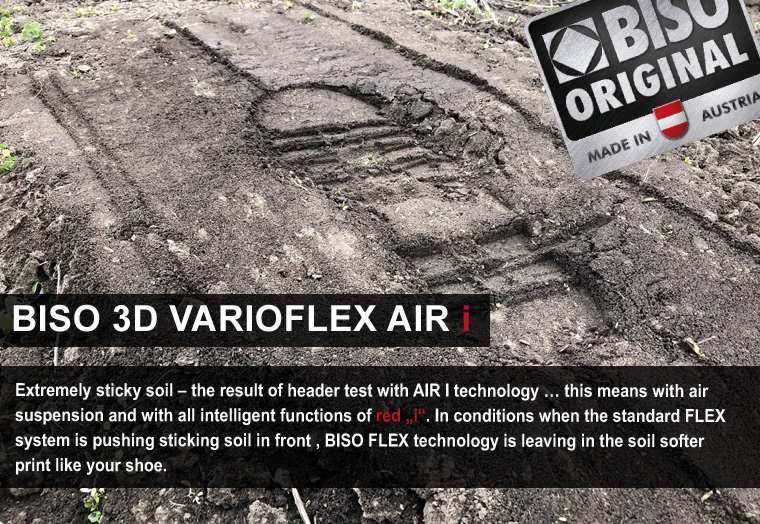
Other interesting articles:
Other interesting articles:
